2013 Peugeot 508 Hybrid oil pressure
[x] Cancel search: oil pressurePage 23 of 340

.
21
Limit the causes of excess
consumption
Spread loads throughout the vehicle; placethe heaviest items in the bottom of the boot,as close as possible to the rear seats.Limit the loads carried in the vehicle and reduce wind resistance (roof bars, roof rack, bicycle carrier, trailer...). Use a roof box inpreference.Remove roof bars and roof racks after use.
At the end of winter, remove snow tyres and refit your summer tyres.
Observe the recommendations
on maintenance
Check the tyre pressures regularly, when cold, referring to the label in the door aper ture, driver's side.Carry out this check in par ticular:- before a long journey,- at each change of season,- after a long period out of use. Don't forget the spare wheel and the tyres onany trailer or caravan.
Have your vehicle ser viced regularly (engine oil, oil filter, air filter...) and obser ve the schedule of operations recommended by the
manufacturer.
When refuelling, do not continue after the3 rd
cut-off of the nozzle to avoid any over flow.
At the wheel of your new vehicle, it is only after the first 1 800 miles (3 000 kilometres) that you will see the fuel consumption settledown to a consistent average.
Page 30 of 340
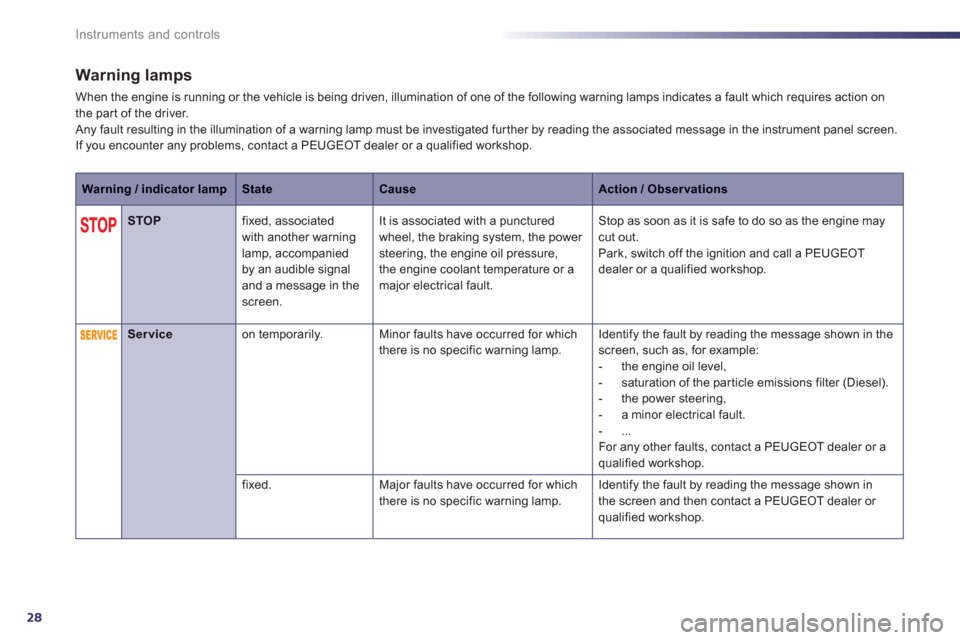
28
Instruments and controls
Warning lamps
When the engine is running or the vehicle is being driven, illumination of one of the following warning lamps indicates a fault which requires action on
the par t of the driver.
Any fault resulting in the illumination of a warning lamp must be investigated fur ther by reading the associated message in the instrument panel screen.
If you encounter any problems, contact a PEUGEOT dealer or a qualified workshop.
Warning / indicator lampStateCauseAction / Observations
STOPfixed, associated
with another warning
lamp, accompanied
b
y an audible signaland a message in the screen. It is associated with a
punctured
wheel, the braking system, the power steering, the engine oil pressure,
the engine coolant temperature or a major electrical fault.
Stop as soon as it is safe to do so as the engine may cut out.
Park, switch off the ignition and call a PEUGEOT
dealer or a qualified workshop.
Serviceon temporarily.Minor faults have occurred for which
there is no specific warning lamp. Identify the fault by reading the message shown in the screen, such as, for example:
- the engine oil level,
- saturation o
f the par ticle emissions filter (Diesel).
- the power steering,
- a minor electrical fault.
-
...
For any other faults, contact a PEUGEOT dealer or a
qualified workshop.
fix
ed.Major faults have occurred for which
there is no specific warning lamp. Identify the fault by reading the message shown in
the screen and then contact a PEUGEOT dealer or
qualified workshop.
Page 33 of 340
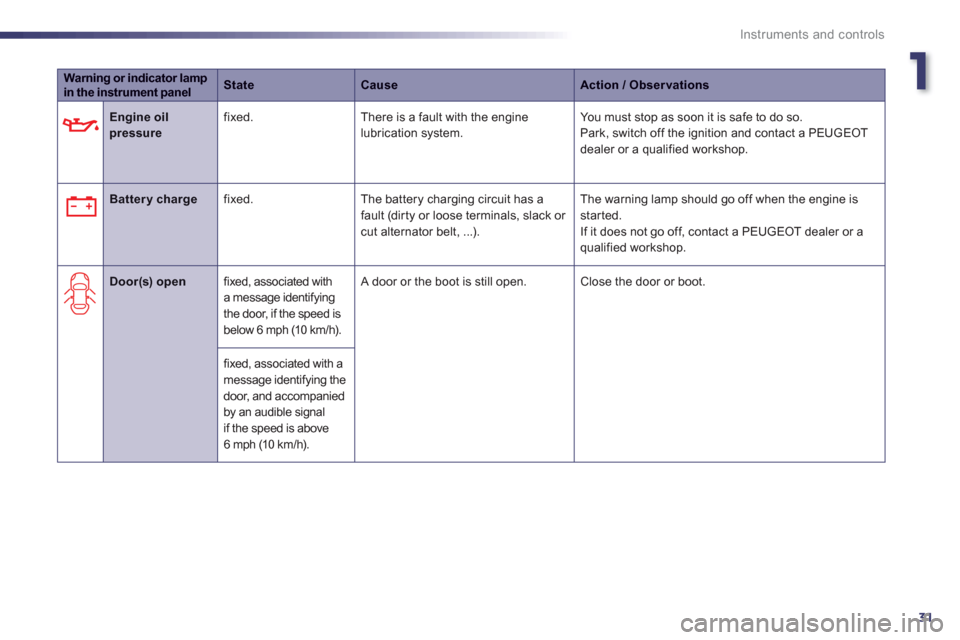
1
31
Instruments and controls
Warning or indicator lamp in the instrument panelStateCauseAction / Observations
Engine oilpressure
fixed. There is a fault with the enginelubrication system. You must stop as soon it is safe to do so.
Park, switch off the ignition and contact a PEUGEOT
dealer or a qualified workshop.
Batter y charge
fixed. The battery charging circuit has a fault (dirty or loose terminals, slack or cut alternator belt, ...). The warning lamp should go o
ff when the engine is started.
If it does not go off, contact a PEUGEOT dealer or a qualified workshop.
Door(s) open
fixed, associated with
a message identifying
the door, if the speed is
below 6 mph
(10 km/h).
A door or the boot is still open. Close the door or boot.
fixed
, associated with a
message identifying the door, and accompanied by an audible signalif the speed is above6 mph (10 km/h).
Page 35 of 340
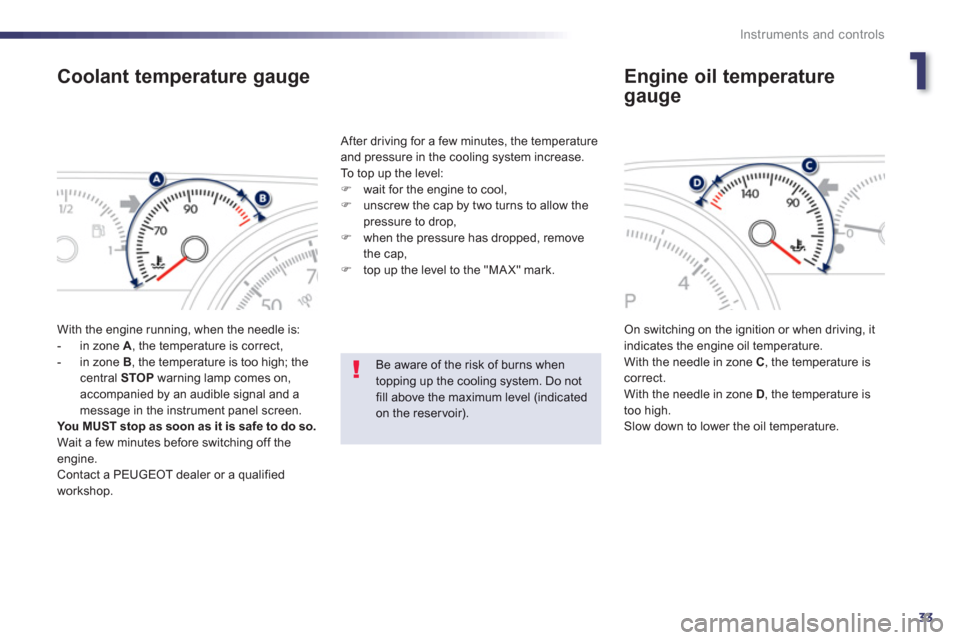
1
33
Instruments and controls
Coolant temperature gauge
With the engine running, when the needle is:
- in zone A
, the temperature is correct,
- in zone B, the temperature is too high; the central STOP
warning lamp comes on,accompanied by an audible signal and amessage in the instrument panel screen.You MUST stop as soon as it is safe to do so.
Wait a few minutes before switching off theengine.
Contact a PEUGEOT dealer or a qualified
workshop.
After drivin
g for a few minutes, the temperatureand pressure in the cooling system increase.
To top up the level:
Fwait for the engine to cool, Funscrew the cap by two turns to allow the
pressure to drop,
Fwhen the pressure has dropped, remove
the cap,
Ftop up the level to the "MA X" mark.
On switching on the ignition or when driving, it
indicates the engine oil temperature.
With the needle in zone C , the temperature is correct.
With the needle in zone D , the temperature is
too high.
Slow down to lower the oil temperature.
Engine oil temperature
gauge
Be aware of the risk of burns whentopping up the cooling system. Do not fill above the maximum level (indicatedon the reservoir).
Page 184 of 340
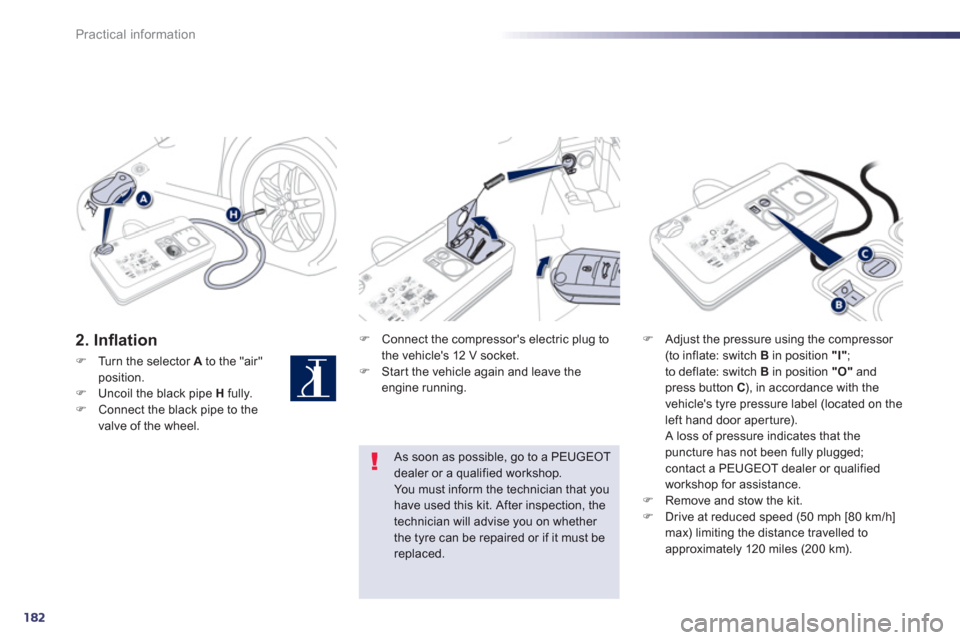
182
Practical information
2. Infl ation F
Connect the compressor's electric plug to
the vehicle's 12 V socket.F Star t the vehicle again and leave the engine running.
F
Adjust the pressure using the compressor (to inflate: switch B
in position "I"
;
to deflate: switch B in position "O"and press button C ), in accordance with the
vehicle's tyre pressure label (located on the
left hand door aper ture).
A loss of pressure indicates that thepuncture has not been fully plugged; contact a PEUGEOT dealer or qualified
workshop for assistance.F Remove and stow the kit.F
Drive at reduced speed (50 mph [80 km/h] max) limiting the distance travelled toapproximately 120 miles (200 km).
As soon as possible, go to a PEUGEOTdealer or a qualified workshop.You must inform the technician that you have used this kit. After inspection, the technician will advise you on whether
the tyre can be repaired or if it must be replaced.
FTurn the selector Ato the "air" position.FUncoil the black pipe Hfully. FConnect the black pipe to the
valve of the wheel.
Page 185 of 340
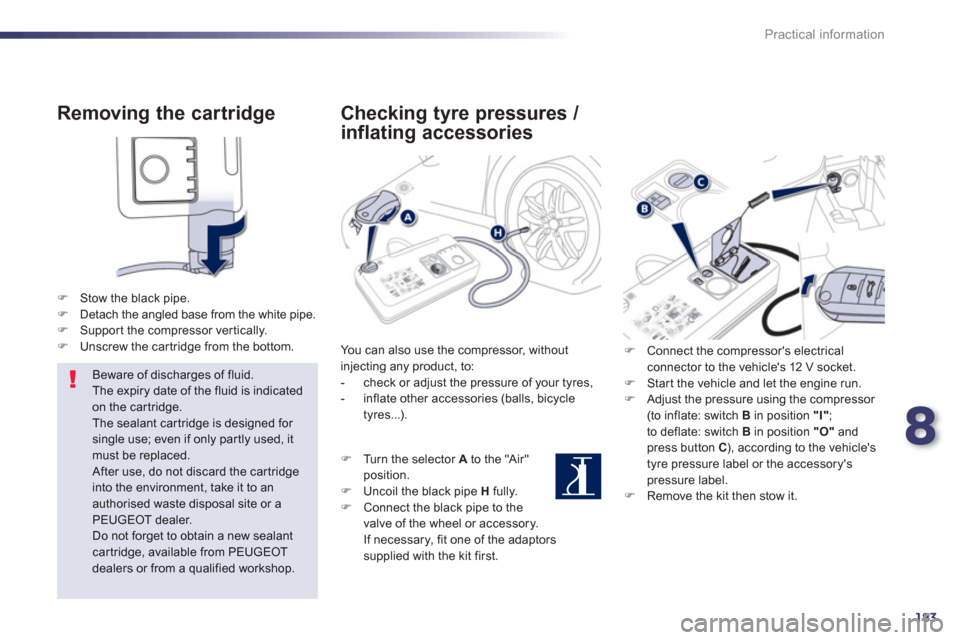
8
183
Practical information
Removing the cartridge
F
Stow the black pipe. F
Detach the angled base from the white pipe.F
Suppor t the compressor ver tically.F
Unscrew the car tridge from the bottom.
Beware of discharges of fluid.
The expiry date of the fluid is indicated on the car tridge.
The sealant car tridge is designed for
single use; even if only partly used, itmust be replaced. After use, do not discard the car tridgeinto the environment, take it to an authorised waste disposal site or a PEUGEOT dealer.
Do not forget to obtain a new sealantcartridge, available from PEUGEOT dealers or from a qualified workshop.
Checking tyre pressures /
inflating accessories
You can also use the compressor, withoutinjecting any product, to:
- check or adjust the pressure of your tyres,
- inflate other accessories (balls, bicycle
tyres...).
FT
urn the selector Ato the "Air"
position.
FUncoil the black pipe
H
fully.FConnect the black pipe to the
valve of the wheel or accessory.
If necessar
y, fit one of the adaptorssupplied with the kit first.
F Connect the compressor's electrical connector to the vehicle's 12 V socket. F
Star t the vehicle and let the engine run. F
Adjust the pressure using the compressor (to inflate: switch B
in position "I"
;
to deflate: switch B in position "O"and press button C), according to the vehicle's
tyre pressure label or the accessory'spressure label. F Remove the kit then stow it.
Page 228 of 340
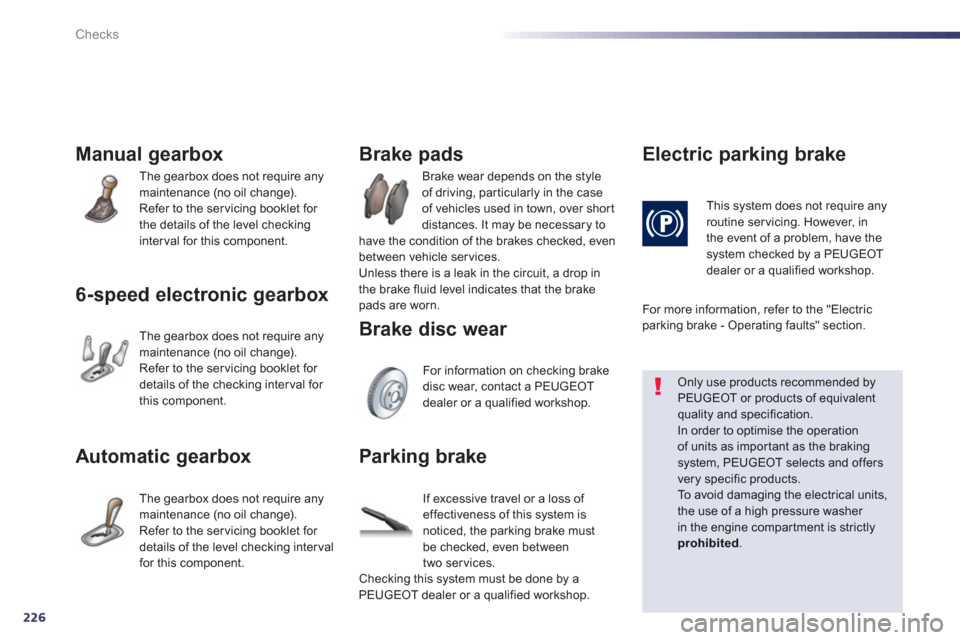
226
Checks
Manual gearbox
The gearbox does not require any
maintenance (no oil change).
Refer to the servicing booklet for
the details of the level checkinginterval for this component.
6-speed electronic gearbox
The gearbox does not require any
maintenance (no oil change).
Refer to the servicing booklet for
details of the checking inter val for
this component.
Automatic gearbox
The gearbox does not require any
maintenance (no oil change).
Refer to the ser vicing booklet for
details of the level checkin
g interval
for this component. Brake wear depends on the st
yle
of driving, par ticularly in the case
of vehicles used in town, over shor t
distances. It ma
y be necessary to
have the condition of the brakes checked, even between vehicle services.
Unless there is a leak in the circuit, a drop in
the brake fluid level indicates that the brake pads are worn.
Brake pads
For information on checking brake
disc wear, contact a PEUGEOT
dealer or a qualified workshop.
Brake disc wear
Electric parkin
g brake
This system does not require any routine servicing. However, in
the event of a problem, have the
system checked by a PEUGEOT
dealer or a qualified workshop.
Only use products recommended by PEUGEOT or products of equivalentquality and specification. In order to optimise the operationof units as impor tant as the braking system, PEUGEOT selects and offersvery specific products.
To a v o i d d a m aging the electrical units,the use of a high pressure washer in the engine compar tment is strictly
prohibited.
Parking brake
If excessive travel or a loss of effectiveness of this system isnoticed, the parking brake must
be checked, even between
tw
o services.
Checking this system must be done by aPEUGEOT dealer or a qualified workshop.
For more information
, refer to the "Electric parking brake - Operating faults" section.
Page 329 of 340
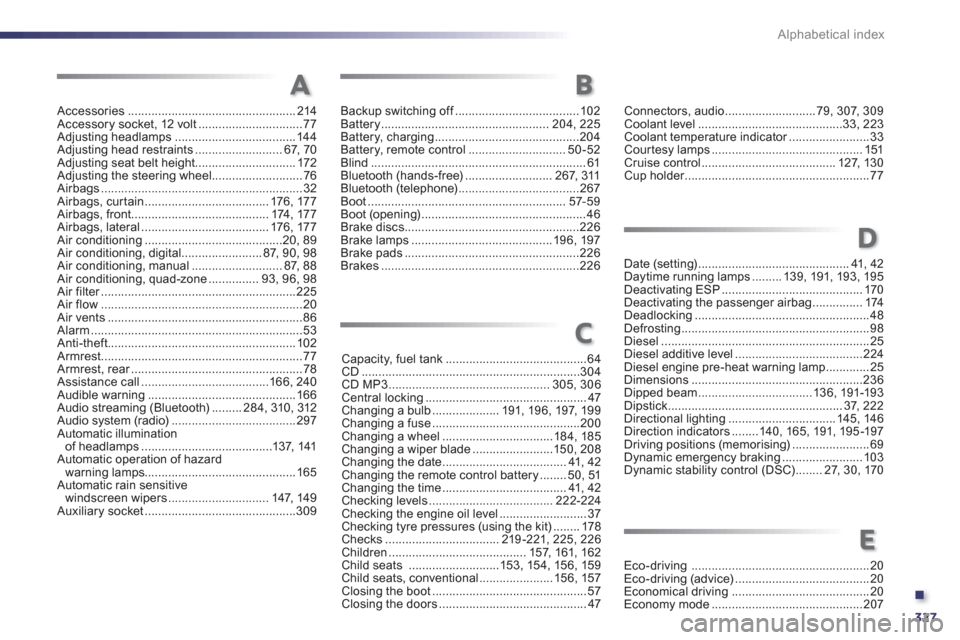
.
327 Alphabetical index
Accessories ..................................................214Accessory socket, 12 volt ...............................77Adjusting headlamps .................................... 144Adjusting head restraints..........................67,70Adjusting seat belt height..............................172Adjusting the steering wheel...........................76Airbags............................................................32Airbags, curtain .....................................176,177Airbags, front.........................................174,177Airbags, lateral......................................176,177Air conditioning.........................................20, 89Air conditioning, digital........................87,90, 98Air conditioning, manual...........................87, 88Air conditioning, quad-zone...............93, 96, 98Air filter..........................................................r225Air flow............................................................20Air vents ..........................................................86Alarm ...............................................................53Anti-theft........................................................102Armrest............................................................77Armrest, rear...................................................r78Assistance call......................................166,240Audible warning............................................166Audio streaming (Bluetooth).........284,310,312Audio system (radio).....................................297Automatic illumination
of headlamps .......................................137, 141Automatic operation of hazard
warning lamps.............................................165Automatic rain sensitive
windscreen wipers..............................147,149Auxiliary socket.............................................309
Backup switching off.....................................f102Battery..................................................204, 225Battery, charging ...........................................204Battery, remote control.............................50-52Blind................................................................61Bluetooth (hands-free)..........................267, 311Bluetooth (telephone)....................................267Boot...........................................................57-59Boot (opening).................................................46Brake discs ....................................................226Brake lamps ..........................................196,197Brake pads ....................................................226Brakes...........................................................226
Capacity, fuel tank..........................................64CD.................................................................304CD MP3 ................................................305, 306Central locking................................................47Changing a bulb ....................191, 196,197, 199Changing a fuse............................................200Changing a wheel.................................184,185Changing a wiper blade........................150,208Changing the date.....................................41,42Changing the remote control battery........50, 51Changing the time.....................................41,42Checking levels .....................................222-224Checking the engine oil level ..........................37Checking tyre pressures (using the kit) ........178Checks ..................................219-221, 225, 226Children.........................................157, 161,162Child seats ...........................153,154,156,159Child seats, conventional......................156, 157Closing the boot..............................................57Closing the doors............................................47
Date (setting).............................................41,42Daytime running lamps.........139, 191,193, 195Deactivating ESP ..........................................170Deactivating the passenger airbag ...............174
Deadlocking ....................................................48Defrosting........................................................98Diesel..............................................................25Diesel additive level......................................224Diesel engine pre-heat warning lamp.............25Dimensions ...................................................236Dipped beam ..................................136,191-193Dipstick ....................................................37, 222Directional lighting ................................ 145, 146Direction indicators........140,165, 191,195-197Driving positions (memorising).......................69Dynamic emergency braking........................103Dynamic stability control (DSC)........27, 30, 170
AB
C
D
Connectors, audio ...........................79, 307, 309Coolant level ...........................................33,223Coolant temperature indicator........................r33Courtesy lamps.............................................151Cruise control........................................127,130Cup holder.......................................................r77
Eco-driving.....................................................20Eco-driving (advice)........................................20Economical driving .........................................20Economy mode .............................................207
E